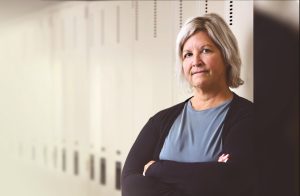By Dr. Holly Witteman
Raise your hand if you feel that 2020 has been exhausting.
(Spoiler: You are not alone, especially if you’ve already been saying that for months.)
Unfortunately, the source of so much mental and physical exhaustion is going to be with us for a while. SARS-CoV-2, the virus that causes COVID-19 disease, is still a threat to human health across Canada and around the world—and although research is making strides towards potential vaccines and treatments every day, we all still need to do our own part to protect ourselves, our loved ones, and our communities.
But making sense of the daily onslaught of COVID-19 headlines and public health guidance can be—you guessed it—exhausting. Plus, advice and policies can change over time as new evidence comes to light, which can be frustrating and can make people doubt which actions are really worth taking.
“The science behind public health measures is not always explained clearly,” says Dr. Holly Witteman, a researcher based at Université Laval and new Canada Research Chair in Human-Centred Digital Health. “And when these things are not clear, it becomes really hard to build trust and encourage behaviour that will help us all deal with and recover from the pandemic.”
There is little research to date about what types of messaging and communication approaches work well to support behaviour change during a pandemic, so public health authorities are in a tough spot as they try to rally their communities to work together and follow the best guidance. To strengthen these efforts, Dr. Witteman is leading a new project to create adaptable digital health materials that will help people better understand the science about COVID-19. Her lab developed an interactive demonstration earlier this year to explain how physical/social distancing can help protect people from the coronavirus, and they now plan to develop similar materials to tackle topics ranging from why public health advice can change (and what it means) to how different prevention measures work to curb community transmission.
“It’s partly that we want to address points of confusion and sources of concern, but there is also a role here for studying how to communicate these kinds of complex topics effectively so that the important information can reach and resonate with as many people as possible,” she explains. “It’s the ‘resonate’ part that can be particularly tough because we are talking about public health guidance that, frankly, is creating challenges in people’s lives.”
These challenges can vary depending on a person’s age, background, living situation, employment and health status, so the project includes a panel of citizen volunteers from across the country who will provide input into everything from resource development to the topics they will cover. These volunteers will advise the research team how the information fits with what they’re hearing in their communities, and the research team will test the materials with people across the country to ensure they have the intended effect.
Once the materials for a given topic have been tested to ensure that they are accurate, understandable, and easy to use, Dr. Witteman’s plan is to release them publicly. All of the materials will be available free of charge to anyone with an internet connection, anywhere in the world. To broaden their reach and accessibility, the materials will be created in English and French, as well as with subtitles in eight additional languages.
“Everything will also be available for adaptation by others,” notes Dr. Witteman. “We plan to share the final materials and software code so that public health authorities, science communicators, community leaders, and anyone else interested in it can use and adapt our work.”
Dr. Witteman expects that the team’s last task in the project will be to create appropriate materials about the SARS-CoV-2 vaccine—when one gets approved for use in Canada, that is. When a vaccine does become available, it will only be successful if enough people actually get vaccinated. If public discussions turn ugly, particularly with blaming and shaming, then people who are nervous or have questions about the vaccine might not know where to turn.
“But it’s perfectly reasonable to have questions,” Dr. Witteman says. “We’ve been telling people for years that they should ask questions about their health and about their options, and that should certainly remain true for a coronavirus vaccine.”
Specifically, the team will be working on what is called a “patient decision aid”, a tool to help people make health care decisions that are informed by research evidence and aligned with their personal values. The tool itself will be ready to include information about whichever vaccine candidate or candidates get approved in Canada, including relevant data from Phase 3 clinical trials. The goal is to connect that information with what matters to the person considering getting vaccinated and how they feel about the potential benefits and potential harms.
“People’s emotions can factor into their decision-making,” Dr. Witteman argues. “This isn’t just about the facts. It’s about what those facts mean for them and for their lives.”
Part of making that connection with people involves providing the ‘why’: why something works, why they are being asked to take a certain action, and why it’s important. And with this research underpinning the best ways to explain the ‘why’ behind public health, hopefully we’ll all get to rest a little easier very soon.
This article was reposted with permission from Canadian Institutes of Health Research. Visit cihr-irsc.gc.ca for more research on COVID-19.














